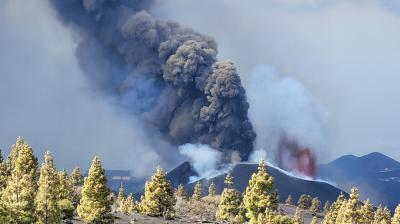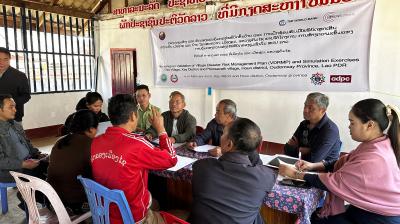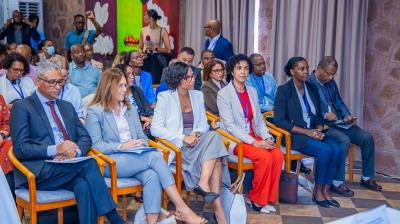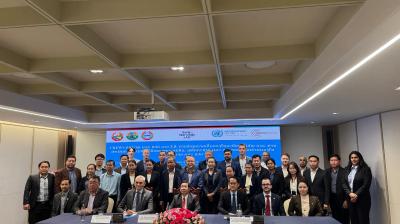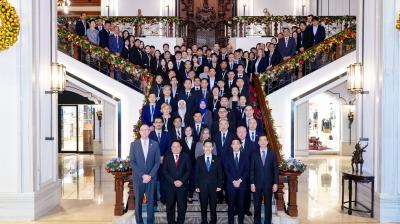Disaster Risk Reduction Day focuses on youth

The International Day for Disaster Risk Reduction 2024 calls on countries to harness the education sector to reduce the disaster risks of school-aged children, especially by investing in two key areas:
- Protect children and youth through safe schools and education facilities: children are entitled to be safe in their schools and this starts with ensuring schools are disaster-resilient and are part of disaster early warning systems.
- Empower children and youth to be safe through age-appropriate education to understand and act on the risks they face. This includes building their preparedness to take early action in response to early warnings. Empowered children become agents of change for more resilient communities.
"Young people must be equipped with skills and knowledge to shape a greener, cleaner, more climate resilient future," said UN Secretary-General António Guterres.
During a visit to the Pacific Islands Forum in Tonga in August, Mr Guterres visited a classroom and presented a new booklet in the Tongan language to encourage children to become disaster champions. These are all in support of the global Early Warnings For All initiative and the Weather Ready Pacific programme.

WMO is convinced that the convergence of Multi-Hazard Early Warning Systems (MHEWS) and youth engagement is crucial for adapting and building resilience to climate change.
With nearly 2 billion young people globally, many reside in regions significantly impacted by climate-related disasters, such as Least Developed Countries (LDCs) and Small Island Developing States (SIDS).
In these regions, MHEWS coverage remains alarmingly low, with only 44% of LDCs and 38% of SIDS reporting effective MHEWS.
The economic toll of disasters is significant, with losses averaging USD 131 billion annually from 2015 to 2022. For LDCs, the financial burden is 7.5 times higher than the global average.
"To avoid burdening youth with the consequences of climate change, it is imperative that we prioritize their involvement in creating and implementing robust MHEWS, thereby paving the way for a sustainable and resilient future," says WMO Secretary-General Celeste Saulo.
"Furthermore, integrating youth perspectives into the development of MHEWS can enhance the effectiveness and relevance of these systems. Young people bring fresh ideas and innovative solutions that can address the unique challenges posed by climate change," she says.
Early Warnings For All
Youth are a key target and driver of the Early Warnings for All (EW4All) initiative.
Multi-hazard Early Warnings Systems (MHEWS) are an integral tool for countries to adapt to the changing climate and to avert, minimize and address losses and damages caused by hazardous events.
As climate change continues to increase the frequency and intensity of hazardous weather events, the initiative seeks to ensure that every person on the planet is protected by effective early warning systems.
Early Warnings For All focuses on building national capacity and systems while integrating regional and global support, as needed, with a particular emphasis on Least Developed Countries (LDCs), Small Island Developing States (SIDS), and fragile and conflict affected (FCV) contexts.
WMO is developing a comprehensive Youth Action Plan, reflecting its commitment to future generations. A number of WMO projects in the field also have an important gender and youth focus.
COPE Disaster Champions
As a contribution to Early Warnings For All, WMO actively supports the COPE Disaster Champions in empowering children with knowledge on climate crisis and disaster risk reduction.
The books cover natural hazards ranging from floods to earthquakes, wildfires to cyclones, storm surge to tsunami. The books provide coping tools, preparedness, and relatable stories in an imaginative way that is easy to understand.
The books have been distributed in 40 countries, more than 3 million children have had access to the series.
WMO has been contributing to the COPE initiative in the following aspects:
WMO serves as a scientific advisor, promoting a creative, narrative, collaborative, and contextually sensitive educational approach to disasters that highlight key messages that are easy for children to remember such as EVACUATE for floods or DROP COVER HOLD for earthquakes.
It seeks to enhance children’s understanding of climate change and extreme weather and disaster risk reduction and equip them with the knowledge and skills to reduce risks and respond effectively to disasters.
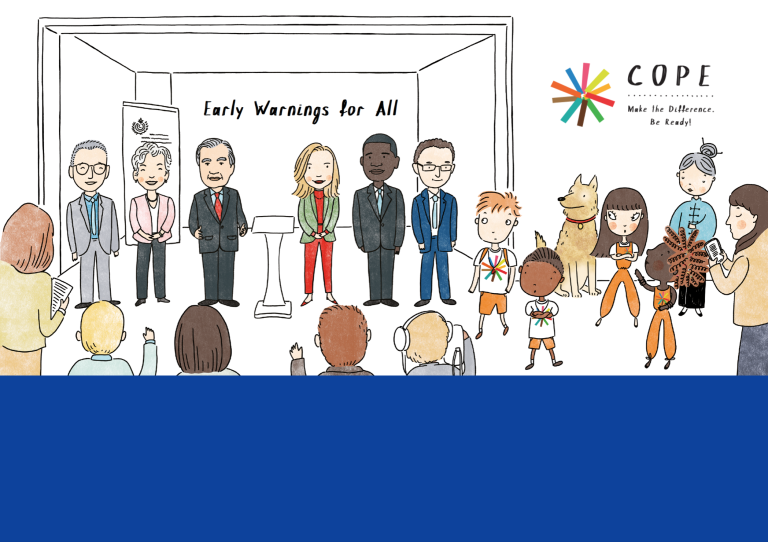
Disasters and Youth
According to the UN Office for Disaster Risk Reduction:
- Disasters are growing and impact the well-being of children and youth.
- A staggering 400 million students globally experienced school closures from extreme weather since 2022.
- Schools have a critical role in promoting a culture of disaster prevention and empowering young people to understand and act on the risks they face.
- Early warning systems should be accessible to children and youth so that no one is left behind.
- Climate crisis is hitting education the hardest in low-income countries, with 18 school days lost annually on average, compared to 2.4 days in wealthier nations.
- Building the preparedness of children and youth can help protect entire families and communities.
- Countries need child-centred DRR policies. This means integrating the needs, vulnerabilities and ideas of children into disaster risk reduction and climate change adaptation plans, with resources dedicated to their implementation.
Youth in Action
For instance, the Boys’ and Girls’ Brigades in Niue were approached by the Niue Meteorological Services to implement the community-based early warning systems component of the Climate Risk and Early Warning Systems Pacific Small Island Developing States (CREWS Pacific SIDS) project, funded by the World Meteorological Organisation (WMO) and implemented by the Secretariat of the Pacific Regional Environment Programme (SPREP).
According to the Director of Niue Meteorological Services, Ms Rossy Mitiepo, they wanted to target the grassroots level when they approached the Girls and Boys Brigade.
"Traditionally we go through the village councils, but we wanted to go right down to the grassroot levels where we can engage communities and get them to support the high-level strategies from the national levels and also at the village level," she said.
Through this partnership, the Met services were able to conduct valuable training to the members of the Girls’ Brigade. They learned of the different terminologies associated with climate science, differentiated between climate and climate change, and also received first-aid training from the National Disaster Management Office (NDMO).
"It was an eye-opening experience working with the Niue Met Service because it was our first time working with a government department," said Ms Viano Motufoou.
"We got to learn a lot about the weather, early warnings, and disaster preparedness, and we were then able to go back to our communities and share this knowledge with the rest of our people."
One of the activities they undertook was the developing of billboards to raise awareness on different aspects of the weather. Through this activity, the young girls learned about the different strengths of cyclones and the colour-coding system used by the Niue Met Service to classify tropical cyclones. They were also able to learn about the El Ninõ-Southern Oscillation and other areas related to weather and climate.
Ms Chantae Vakanofiti, Young Leader for the Girls’ Brigade, said that thanks to the training conducted by the Met service and also the billboards they worked on, she now understands what El Niño and La Niña are and how these events affect our weather.
"I gained a lot of knowledge and experience through this partnership that I will be able to use when I pursue further studies," she said.

The young women have also learned how to plant and harvest ufi, which is a climate indicator in Niue, and monitor them to learn how they behave during the cyclone season. This will ensure that this important traditional knowledge will be passed on to future generations to come.
- Disasters are growing and impact the well-being of children and youth.
- A staggering 400 million students globally experienced school closures from extreme weather since 2022.
- Every child and youth deserves to be protected from disasters, especially at school.
- Schools have a critical role in promoting a culture of disaster prevention and empowering young people to understand and act on the risks they face.
- Early warning systems should be accessible to children and youth so that no one is left behind.
- A one-time investment of $18.51 per child can mitigate the impact from climate shocks.
- Climate crisis is hitting education the hardest in low-income countries, with 18 school days lost annually on average, compared to 2.4 days in wealthier nations.
- Building the preparedness of children and youth can help protect entire families and communities.
- Countries need child-centred DRR policies. This means integrating the needs, vulnerabilities and ideas of children into disaster risk reduction and climate change adaptation plans, with resources dedicated to their implementation.
- Child-centred DRR is grounded in the principles of the UN Convention on the Rights of the Child.
- Schools should be safe learning spaces, where children and staff are protected from ALL risks.
- The Comprehensive School Safety Framework offers governments a way to protect children and schools from all risks and hazards in the education sector.
- Children and youth have the right to safety, security, and protection in schools, to educational continuity, and to participate in decisions that affect their future.
- Over 1 billion children have had their lives disrupted by disasters since 2000, with over 80,000 schools damaged or destroyed. Child rights must be protected for #safechildrensafeschools.
- We’re calling on governments and partners to act now to commit to implementing the Comprehensive School Safety Framework to protect children, educators, staff, & schools - we need a multi-hazard approach to school safety.


